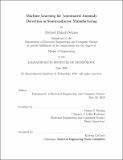| dc.contributor.advisor | Duane S. Boning. | en_US |
| dc.contributor.author | DeLaus, Michael Daniel. | en_US |
| dc.contributor.other | Massachusetts Institute of Technology. Department of Electrical Engineering and Computer Science. | en_US |
| dc.date.accessioned | 2019-11-22T00:02:33Z | |
| dc.date.available | 2019-11-22T00:02:33Z | |
| dc.date.copyright | 2019 | en_US |
| dc.date.issued | 2019 | en_US |
| dc.identifier.uri | https://hdl.handle.net/1721.1/123017 | |
| dc.description | This electronic version was submitted by the student author. The certified thesis is available in the Institute Archives and Special Collections. | en_US |
| dc.description | Thesis: M. Eng., Massachusetts Institute of Technology, Department of Electrical Engineering and Computer Science, 2019 | en_US |
| dc.description | Cataloged from student-submitted PDF version of thesis. | en_US |
| dc.description | Includes bibliographical references (pages 71-72). | en_US |
| dc.description.abstract | In the realm of semiconductor manufacturing, detecting anomalies during manufacturing processes is crucial. However, current methods of anomaly detection often rely on simple excursion detection methods, and manual inspection of machine sensor data to determine the cause of a problem. In order to improve semiconductor production line quality, machine learning tools can be developed for more thorough and accurate anomaly detection. Previous work on applying machine learning to anomaly detection focused on building reference cycles, and using clustering and time series forecasting to detect anomalous wafer cycles. We seek to improve upon these techniques and apply them to related domains of semiconductor manufacturing. The main focus is to develop a process for automated anomaly detection by combining the previously used methods of cluster analysis and time series forecasting and prediction. We also explore detecting anomalies across multiple semiconductor manufacturing machines and recipes. | en_US |
| dc.description.statementofresponsibility | by Michael Daniel DeLaus. | en_US |
| dc.format.extent | 72 pages | en_US |
| dc.language.iso | eng | en_US |
| dc.publisher | Massachusetts Institute of Technology | en_US |
| dc.rights | MIT theses are protected by copyright. They may be viewed, downloaded, or printed from this source but further reproduction or distribution in any format is prohibited without written permission. | en_US |
| dc.rights.uri | http://dspace.mit.edu/handle/1721.1/7582 | en_US |
| dc.subject | Electrical Engineering and Computer Science. | en_US |
| dc.title | Machine learning for automated anomaly detection in semiconductor manufacturing | en_US |
| dc.type | Thesis | en_US |
| dc.description.degree | M. Eng. | en_US |
| dc.contributor.department | Massachusetts Institute of Technology. Department of Electrical Engineering and Computer Science | en_US |
| dc.identifier.oclc | 1127603501 | en_US |
| dc.description.collection | M.Eng. Massachusetts Institute of Technology, Department of Electrical Engineering and Computer Science | en_US |
| dspace.imported | 2019-11-22T00:02:33Z | en_US |
| mit.thesis.degree | Master | en_US |
| mit.thesis.department | EECS | en_US |
